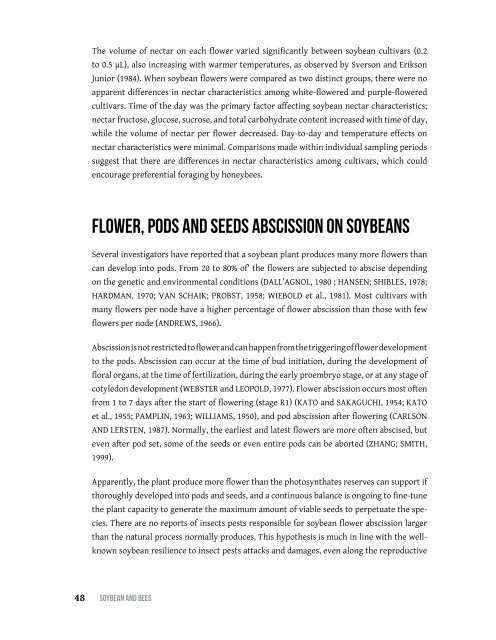Soybean and Bees
You also want an ePaper? Increase the reach of your titles
YUMPU automatically turns print PDFs into web optimized ePapers that Google loves.
The volume of nectar on each flower varied significantly between soybean cultivars (0.2<br />
to 0.5 μL), also increasing with warmer temperatures, as observed by Sverson <strong>and</strong> Erikson<br />
Junior (1984). When soybean flowers were compared as two distinct groups, there were no<br />
apparent differences in nectar characteristics among white-flowered <strong>and</strong> purple-flowered<br />
cultivars. Time of the day was the primary factor affecting soybean nectar characteristics;<br />
nectar fructose, glucose, sucrose, <strong>and</strong> total carbohydrate content increased with time of day,<br />
while the volume of nectar per flower decreased. Day-to-day <strong>and</strong> temperature effects on<br />
nectar characteristics were minimal. Comparisons made within individual sampling periods<br />
suggest that there are differences in nectar characteristics among cultivars, which could<br />
encourage preferential foraging by honeybees.<br />
Flower, pods <strong>and</strong> seeds abscission on soybeans<br />
Several investigators have reported that a soybean plant produces many more flowers than<br />
can develop into pods. From 20 to 80% of’ the flowers are subjected to abscise depending<br />
on the genetic <strong>and</strong> environmental conditions (Dall’Agnol, 1980 ; Hansen; Shibles, 1978;<br />
Hardman, 1970; Van Schaik; Probst, 1958; Wiebold et al., 1981). Most cultivars with<br />
many flowers per node have a higher percentage of flower abscission than those with few<br />
flowers per node (ANDREWS, 1966).<br />
Abscission is not restricted to flower <strong>and</strong> can happen from the triggering of flower development<br />
to the pods. Abscission can occur at the time of bud initiation, during the development of<br />
floral organs, at the time of fertilization, during the early proembryo stage, or at any stage of<br />
cotyledon development (WEBSTER <strong>and</strong> LEOPOLD, 1977). Flower abscission occurs most often<br />
from 1 to 7 days after the start of flowering (stage R1) (Kato <strong>and</strong> Sakaguchi, 1954; Kato<br />
et al., 1955; Pamplin, 1963; Williams, 1950), <strong>and</strong> pod abscission after flowering (Carlson<br />
<strong>and</strong> Lersten, 1987). Normally, the earliest <strong>and</strong> latest flowers are more often abscised, but<br />
even after pod set, some of the seeds or even entire pods can be aborted (Zhang; Smith,<br />
1999).<br />
Apparently, the plant produce more flower than the photosynthates reserves can support if<br />
thoroughly developed into pods <strong>and</strong> seeds, <strong>and</strong> a continuous balance is ongoing to fine-tune<br />
the plant capacity to generate the maximum amount of viable seeds to perpetuate the species.<br />
There are no reports of insects pests responsible for soybean flower abscission larger<br />
than the natural process normally produces. This hypothesis is much in line with the wellknown<br />
soybean resilience to insect pests attacks <strong>and</strong> damages, even along the reproductive<br />
48 SoybeAn <strong>and</strong> bees


